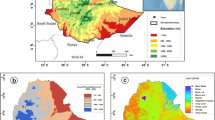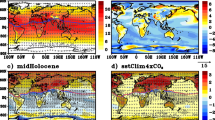Abstract
The Tibetan Plateau (TP) surfaces have been experiencing an overall rapid warming and wetting while wind speed and solar radiation have been declining in the last three decades. This study investigated how climate changes influenced the hydrological cycle on the TP during 1984∼2006. To facilitate the analysis, a land surface model was used to simulate surface water budget at all CMA (China Meteorological Administration) stations on the TP. The simulated results were first validated against observed ground temperature and observation-derived heat flux on the western TP and observed discharge trends on the eastern TP. The response of evaporation and runoff to the climate changes was then analyzed. Major finding are as follows. (1) Surface water balance has been changed in recent decades. Observed precipitation shows insignificant increasing trends in central TP and decreasing trends along the TP periphery while evaporation shows overall increasing trends, leading to decreased discharge at major TP water resource areas (semi-humid and humid zones in the eastern and southern TP). (2) At the annual scale, evaporation is water-limited in dry areas and energy-limited (radiation and air temperature) in wet areas; these constraints can be interpreted by the Budyko-curve. Evaporation in autumns and winters was strongly controlled by soil water storage in summers, weakening the dependence of evaporation on precipitation at seasonal scales. (3) There is a complementary effect between the simulated actual evaporation and potential evaporation, but this complementary relationship may deviate from Bouchet’s hypothesis when vapor pressure deficit (or air temperature) is too low, which suppresses the power of vapor transfer.
Similar content being viewed by others
References
Berezovskaya S, Yang D, Hinzman L (2005) Long-term annual water balance analysis of the Lena River. Glob Planet Change 48:84–95
Bouchet RJ (1963) Evapotranspiration reélle evapotranspiration potentielle, signification climatique. Int Assoc Sci Hydrol Publ 62:134–142. Berkeley California
Brutsaert W, Parlange M (1998) Hydrologic cycle explains the evaporation paradox. Nature 396:30. doi:10.1038/23845
Budyko MI (1974) Climate and life. Academic, New York
Cao JT, Qin DH, Kang ES, Li YY (2006) River discharge changes in the Qinghai-Tibet Plateau. Chin Sci Bull 51:594–600
Chattopadhyay N, Hulme M (1997) Evaporation and potential evapotranspiration in India under conditions of recent and future climate change. Agric For Meteorol 87:55–72
Chen SB, Liu YF, Thomas A (2006) Climatic change on the Tibetan Plateau: potential evapotranspiration trends from 1961–2000. Clim Change 76:291–319
Crawford TM, Duchon CE (1999) An improved parameterization for estimating effective atmospheric emissivity for use in calculating daytime downwelling long-wave radiation. J Appl Meteorol 38:474–480
Fuh BP (1981) On the calculation of the evaporation from land surface (in Chinese). Chinese J Atmos Sci 5:23–31
Gao G, Chen DL, Xu CY, Simelton E (2007) Trend of estimated actual evapotranspiration over China during 1960–2002. J Geophys Res 112:D11120. doi:10.1029/2006JD008010
Global Soil Data Task (2000) Global Gridded Surfaces of Selected Soil Characteristics (IGBPDIS), International Geosphere-Biosphere Programme—Data and Information Services. Oak Ridge National Laboratory, Oak Ridge, available online at: http://www.daac.ornl.gov/
Hobbins MT, Ramirez JA, TC Brown (2004) Trends in pan evaporation and actual evapotranspiration across the conterminous US: paradoxical or complementary? Geophys Res Lett 31:L13503. doi:10.1029/2004GL019846
Jiang Y, Yong Y, Zhao ZC, Tao SW (2010) Changes in wind speed over China during 1956–2004. Theor Appl Climatol 99:421–430. doi:10.1007/s00704-009-0152-7
Kahler DM, Brutsaert W (2006) Complementary relationship between daily evaporation in the environment and pan evaporation. Water Resour Res 42:W05413. doi:10.1029/2005wr004541
Kang S, Xu Y, You Q, Flügel W-A, Pepin N, Yao T (2010) Review of climate and cryospheric change in the Tibetan Plateau. Environ Res Lett 5:015101. doi:10.1088/1748-9326/5/1/015101
Kattsov VM, Walsh JE (2000) Twentieth-century trends of arctic precipitation from observational data and a climate model simulation. J Clim 13:1362–1370
Knyazikhin Y et al (1999) MODIS leaf area index (LAI) and fraction of photosynthetically active radiation absorbed by vegetation (FPAR) product, (MOD15). Algorithm theoretical basis document version 4.0. [Available online at http://modis.gsfc.nasa.gov/data/atbd/atbd_mod15.pdf]
Li Q, Sun S, Dai Q (2009) The numerical scheme development of a simplified frozen soil model. Adv Atmos Sci 26:940–950
Liu B, Xu M, Henderson M, Gong W (2004) A spatial analysis of pan evaporation trends in China, 1955–2000. J Geophys Res 109:D15102. doi:10.1029/2004JD004511
Liu XD, Chen BD (2000) Climatic warming in the Tibetan Plateau during recent decades. Int J Climatol 20:1729–1742
Loveland TR, Reed BC, Brown JF, Ohlen DO, Zhu Z, Yang L, Merchant JW (2001) Development of a global land cover characteristics database and IGBP DISCover from 1-km AVHRR data. Int J Remote Sens 21:1303–1330
Ma, Y, Kang S, Zhu L, Xu B, Tian L, Yao T (2008) Tibetan Observation and Research Platform- Atmosphere–land interaction over a heterogeneous landscape. Bull Amer Meteor Soc 89:1487–1492
Peterson BJ, Holmes RM, McClelland JW, Vorosmarty CJ, Lammers RB, Shiklomanov AI, Shiklomanov IA, Rahmstorf S (2002) Increasing river discharge to the Arctic Ocean. Science 298:2171–2173
Peterson TC, Golubev VS, Groisman PY (1995) Evaporation losing its strength. Nature 377:687–688
Priestley CHB, Taylor RJ (1972) On the assessment of surface heat flux and evaporation using large-scale parameters. Mon Wea Rev 100:81–82
Qin J, Yang K, Liang SL, Guo XF (2009) The altitudinal dependence of recent rapid warming over the Tibetan Plateau. Clim Change 97:321–327
Ramírez JA, Hobbins MT, Brown TC (2005) Observational evidence of the complementary relationship in regional evaporation lends strong support for Bouchet’s hypothesis. Geophys Res Lett 32:L15401. doi:10.1029/2005GL023549
Roderick ML, Farquhar GD (2004) Changes in Australian pan evaporation from 1970 to 2002. Int J Climatol 24:1077–1090
Ross PJ (2003) Modeling soil water and solute transport—fast, simplified numerical solutions. Agron J 95:1352–1361
Sellers PJ, Randall DA, Collatz GJ, Berry JA, Field CB, Dazlich DA, Zhang C, Collelo GD, Bounoua L (1996) A revised land surface parameterization (SiB2) for atmospheric GCMs, Part I: model formulation. J Climate 9:676–705
Shuttleworth WJ (1993) Evaporation. In: Maidment DR (ed) Handbook of hydrology, Chap. 4. McGraw-Hill, New York, pp 4.1–4.53
Tian L, Yao T, Li Z, MacClune K, Wu G, Xu B, Li Y, Lu A, Shen Y (2006) Recent rapid warming trend revealed from the isotopic record in Muztagata ice core, eastern Pamirs. J Geophys Res 111:D13103. doi:10.1029/2005JD006249
Watanabe T, Kondo J (1990) The influence of canopy structure and density upon the mixing length within and above vegetation. J Meteorol Soc Jpn 68:227–235
Wild M, Gilgen H, Roesch A, Ohmura A, Long CN, Dutton EG, Forgan B, Kallis A, Russak V, Tsvetkov A (2005) From dimming to brightening: decadal changes in solar radiation at earth’s surface. Science 308:847–850. doi:10.1126/science.1103215
Wild M, Grieser J, Schär C (2008) Combined surface solar brightening and increasing greenhouse effect support recent intensification of the global land-based hydrological cycle. Geophys Res Lett 35:L17706. doi:10.1029/2008GL034842
Xu M, Chang CP, Fu C, Qi Y, Robock A, Robinson D, Zhang H (2006) Steady decline of East Asian monsoon winds, 1969–2000: evidence from direct ground measurements of wind speed. J Geophys Res 111:D24111. doi:10.1029/2006JD007337
Yang K, Koike T, Ye B (2006) Improving estimation of hourly, daily, and monthly downward shortwave radiation by importing global data sets. Agric Forest Meteorol 137:43–55
Yang K, Koike T, Ishikawa H, Kim J, Li X, Liu H, Liu S, Ma Y, Wang J (2008) Turbulent flux transfer over bare-soil surfaces: characteristics and parameterization. J Appl Meteorol Clim 40:276–290
Yang K, Chen YY, Qin J (2009a) Some practical notes on the land surface modeling in the Tibetan Plateau. Hydrol Earth Syst Sci 13:687–701
Yang K, Qin J, Guo XF, Zhou DG, Ma Y (2009b) Method development for estimating sensible heat flux over the Tibetan Plateau from CMA data. J Appl Meteorol Clim 48:2474–2486
Yang K, He J, Tang WJ, Qin J, Cheng CK (2010) On downward shortwave and longwave radiations over high altitude regions: observation and modeling in the Tibetan Plateau. Agric Forest Meterol 150:38–46
Ye B, Yang D, Ding Y, Han T, Koike T (2004) A bias-corrected precipitation climatology for China. J Hydrometeorol 5:1147–1160
Ye Q, Zhu L, Zheng H, Naruse R, Zhang X, Kang S (2007) Glacier and lake variations in the Yamzhog Yumco Basin in the last two decades using remote sensing and GIS technologies. J Glaciol 53:673–676
Yu J, Zhang Y, Liu C (2009) Validity of the Bouchet’s complementary relationship at 102 observatories across China. Sci China Ser D-Earth Sci 52:708–713
Zhang Y, Liu C, Tang Y, Yang Y (2007) Trends in pan evaporation and reference and actual evapotranspiration across the Tibetan Plateau. J Geophys Res 112:D12110. doi:10.1029/2006JD008161
Author information
Authors and Affiliations
Corresponding author
Rights and permissions
About this article
Cite this article
Yang, K., Ye, B., Zhou, D. et al. Response of hydrological cycle to recent climate changes in the Tibetan Plateau. Climatic Change 109, 517–534 (2011). https://doi.org/10.1007/s10584-011-0099-4
Received:
Accepted:
Published:
Issue Date:
DOI: https://doi.org/10.1007/s10584-011-0099-4




